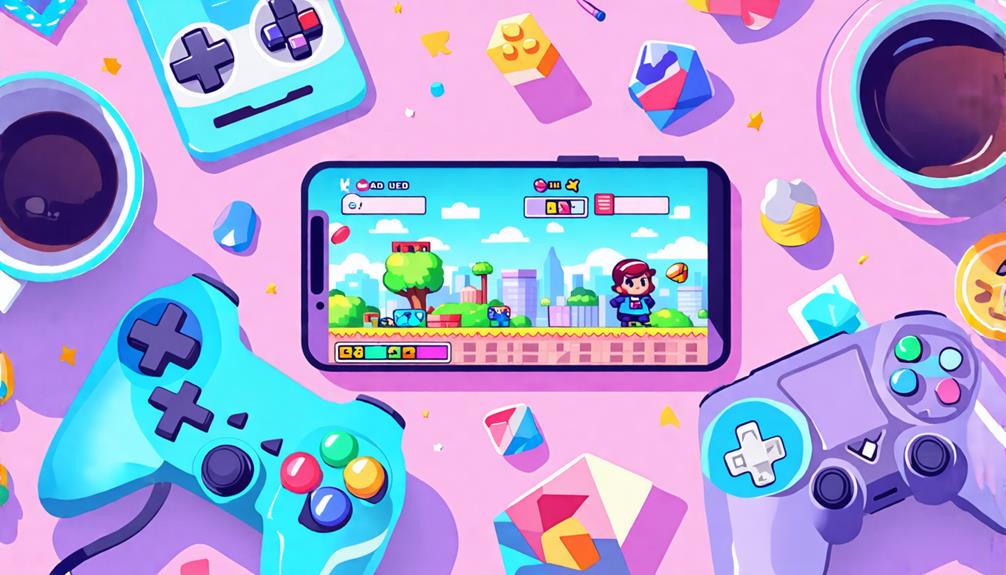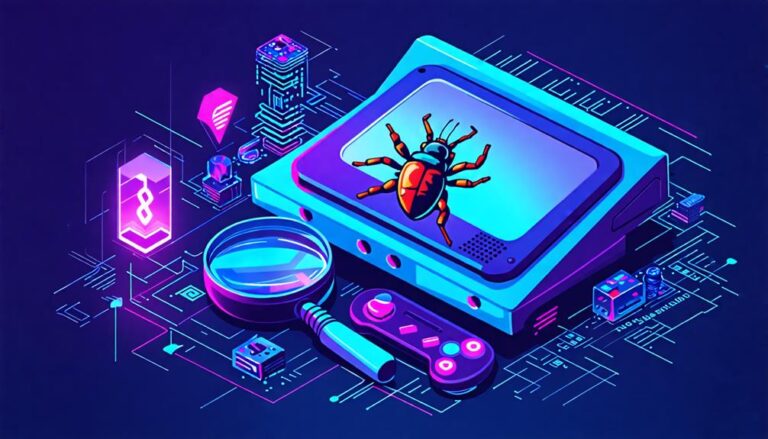Developing a game app that resonates with casual gamers can be a rewarding side hustle, especially if you know where to start. Your target audience is likely to be women aged 25-45, who prefer bite-sized gaming sessions and intuitive mechanics. To capture their attention, you'll need to design an interface that's user-friendly and visually appealing. Here's how you can implement this side hustle effectively:
- Understand Your Audience: Casual gamers typically enjoy simple, engaging gameplay. They often look for games that can be played in short bursts, making it essential to create levels or sessions that last just a few minutes.
- Design an Intuitive Interface: The interface should be easy to navigate. Use clear icons, simple menus, and ensure controls are straightforward. A visually appealing design, with bright colors and pleasing graphics, can significantly enhance user experience.
- Balance Challenge and Reward: Striking the right balance between challenge and reward is key. Levels should be progressively challenging but not frustratingly difficult. Regular rewards, such as bonuses or new levels, can keep players engaged.
- Incorporate Social Sharing Options: Allow players to share their achievements on social media. This not only makes the experience more enjoyable but also helps in organic marketing of your game.
- Monetization Strategies: Think about how you will monetize your game. Options include in-app purchases, ads, or a one-time purchase price. Ensure that the monetization strategy does not hinder the user experience.
By understanding your audience and focusing on user-friendly design, balanced gameplay, social features, and effective monetization, you can develop a game app that stands out in the crowded market and turns into a successful side hustle.
Understanding Casual Gamer Behavior
To develop game apps that truly resonate with casual gamers as a side hustle, you need to explore the specifics of their behavior: what motivates them to download a game, what keeps them engaged, and what triggers their decision to monetize or abandon an app?
Understanding casual gamer demographics is key to creating an appealing game. You'll want to know the age range, interests, and preferences of your target audience. For instance, women aged 25-45 are a significant segment of casual gamers, often enjoying puzzle and match-3 games.
Analyzing gaming session duration is also essential. Casual gamers typically play in short, frequent sessions, ranging from 5-15 minutes. Your game should accommodate these brief play sessions, offering bite-sized experiences and easy-to-achieve goals.
By recognizing these patterns, you can design an engaging game that meets the needs of casual gamers. This understanding will also inform your monetization strategies, helping you balance revenue goals with player satisfaction.
Designing Intuitive Gameplay Mechanics
By focusing on simplicity and user-friendly interactions, you'll create gameplay mechanics that seamlessly guide players through the game, fostering an intuitive experience that's both engaging and rewarding.
To achieve this, you'll want to design game mechanics that provide clear and concise feedback to players. This feedback can come in various forms, such as visual, auditory, or haptic cues, and should help players understand the consequences of their actions.
When implementing game mechanics, consider the player's cognitive load and avoid overwhelming them with complex rules or convoluted systems. Instead, focus on creating a streamlined experience that allows players to quickly grasp the game's fundamentals.
Playtesting and player feedback are essential in identifying areas where game mechanics may be unclear or unintuitive. By iterating on your design and incorporating player feedback, you can refine your game mechanics to create a more engaging and enjoyable experience for casual gamers.
Effective game mechanics will keep players invested and motivated, leading to a more satisfying gaming experience.
Creating Simple Yet Effective Graphics
As you design the visual aspects of your game app as a side hustle, you'll want to create a cohesive look that enhances the gaming experience.
You'll need to select a color scheme that's not only visually appealing but also easy on the eyes, taking into account factors like contrast and legibility.
By carefully placing visual elements, such as buttons and menus, you can craft a user-friendly interface that streamlines gameplay and reduces distractions.
Ultimately, this approach increases user satisfaction and boosts your app's success.
Color Scheme Selection
Selecting a color scheme that reflects your side hustle's personality and resonates with your target audience is an essential step in creating simple yet effective graphics for your business. You'll want to take into account color psychology, as different hues can evoke various emotions and reactions from your customers.
For example, blue is often associated with trust and calmness, while red can stimulate excitement and energy. By choosing colors that align with your side hustle's tone and atmosphere, you'll create a more engaging and memorable experience for your audience.
To create a visually appealing color scheme, you'll also need to consider color harmony. This refers to the way colors work together to create a cohesive and aesthetically pleasing palette.
You can achieve color harmony by selecting colors that are analogous (next to each other on the color wheel), complementary (opposite each other on the color wheel), or triadic (equidistant from each other on the color wheel). By applying these color theory principles, you'll be able to craft a color scheme that enhances your side hustle's branding and attracts your target audience.
Visual Element Placement
When designing graphics for your side hustle app, strategically placing visual elements such as text, images, and icons is crucial for creating a clear visual hierarchy that effectively communicates your message and captures the user's attention. This involves achieving element balance by distributing visual weights, colors, and textures to guide the user's eye through the interface. A well-crafted visual hierarchy enables users to quickly understand your app's unique value, services offered, and user feedback.
To create an effective visual hierarchy for your side hustle app, consider the following element placement strategies:
| Visual Element | Placement | Effect |
|---|---|---|
| Primary action buttons (e.g., "Buy Now", "Contact Us") | Prominent, top-left or center | Encourages user interaction and conversions |
| Services and offerings | Clear, concise, and easily accessible | Reduces cognitive load and informs potential customers |
| User feedback and testimonials | Timely, contextual, and non-obtrusive | Builds trust and enhances user engagement |
| Background graphics | Subtle, visually appealing, and uncluttered | Supports brand identity and professionalism |
Building a User-Friendly Interface
Creating an intuitive interface is crucial for side hustle apps, where users need to efficiently manage tasks and resources with minimal learning curve. As you design your side hustle app's interface, it's important to prioritize user feedback and incorporate accessibility features to serve a diverse audience.
When building a user-friendly interface, consider the following:
- Consistent Navigation: Use clear and consistent navigation patterns to ensure users can easily access app features and settings.
- Visual Clarity: Utilize high-contrast colors, clear typography, and intuitive icons to make your app visually appealing and easy to understand.
- Streamlined Menus: Limit menu options and avoid overwhelming users with too much information, allowing them to quickly access essential tools, tasks, and settings.
- Feedback Mechanisms: Implement feedback mechanisms, such as notifications, sound effects, or animations, to provide users with immediate feedback on their actions within the app.
Crafting Engaging Game Levels
As you design game levels for your side hustle, you'll want to apply key level design principles to keep players engaged and motivated.
Balancing challenges and rewards is crucial to building player momentum, ensuring that the gameplay experience is neither too easy nor too frustrating.
Level Design Principles
Your side hustle's level design is essential in determining the user's overall experience, and a well-crafted design keeps users engaged, motivated, and enthusiastic to continue. As you develop your side hustle, consider the progression and storytelling that will unfold. You want users to feel a sense of accomplishment and satisfaction as they overcome challenges and make progress.
To accomplish this, keep the following design principles in mind:
- Create a clear structure: Break down tasks into manageable sections, each with its own objectives and challenges.
- Gradually introduce new elements: Ease users into new aspects of your side hustle, allowing them to master each component before adding more complexity.
- Use storytelling: Weave narrative elements into your side hustle, using visual and audio cues to convey the story and atmosphere.
- Balance difficulty and reward: Ensure that challenges are tough but not insurmountable, with satisfying rewards for overcoming obstacles.
Building Player Momentum
By applying effective strategies for your side hustle, you can create a foundation for building momentum, where each task flows logically into the next, keeping you engaged and enthusiastic to tackle new challenges. To further enhance your engagement, focus on crafting goals that provide instant feedback, allowing you to adjust your approach and track your progress.
| Element | Description | Impact on Momentum |
|---|---|---|
| Clear objectives | Define what you must accomplish | Provides direction and focus |
| Increasing difficulty | Gradually introduce new challenges | Maintains interest and growth |
| Feedback loops | Deliver timely, relevant feedback on progress | Encourages you to adjust strategy |
| Varied tasks | Mix up your activities and challenges | Prevents monotony and stimulates curiosity |
| Sense of progression | Reward yourself for achieving milestones | Fosters motivation and enthusiasm |
Increasing Difficulty Gradually
Building a successful side hustle is akin to crafting engaging game levels, requiring a careful balance between challenge and progression. Just as in game design, where each level builds on the previous one to create a sense of escalating difficulty, your side hustle should develop in stages that keep you motivated and invested.
The goal is to create a sense of flow, where you're fully immersed in your side hustle, without feeling too overwhelmed or complacent. To achieve this, focus on increasing your efforts and challenges gradually, using various techniques to create a smooth learning curve.
Here are some key considerations to keep in mind:
- Start with a gentle slope: Begin with small, manageable tasks that allow you to get accustomed to your side hustle before taking on more significant challenges.
- Use feedback: Gather insights from customers, mentors, or analytics to adjust your approach, ensuring that your side hustle remains engaging and viable.
- Introduce new challenges: As you gain confidence, add new projects, diversify your offerings, or explore different markets to keep your side hustle fresh and exciting.
- Test and refine: Continuously evaluate your progress and refine your strategies to ensure a seamless and rewarding side hustle experience.
Incorporating Reward Systems Effectively
One key aspect of designing engaging game apps for casual gamers as a side hustle is incorporating a well-structured reward system that motivates players to continue playing. You'll want to create a system that's easy to understand, yet challenging to master.
To achieve this, you'll need to establish clear reward tiers that provide a sense of progression and accomplishment. Each tier should offer increasingly desirable rewards that align with the player's growing skills and investment.
When designing your incentive structures, consider using a mix of intrinsic and extrinsic motivators. Intrinsic rewards, such as gaining access to new levels or characters, tap into the player's natural curiosity and desire for exploration.
Extrinsic rewards, like points, badges, or leaderboards, provide a sense of competition and social validation. By balancing these elements, you'll create a reward system that's both engaging and sustainable.
As players progress, your system should adapt to their changing needs, offering new challenges and rewards that maintain their interest and motivation. By incorporating a well-designed reward system, you'll keep your players engaged and coming back for more, ensuring your side hustle remains successful and lucrative.
Implementing Social Sharing Features
Enhancing Player Engagement Through Social Sharing in Your Side Hustle Game App
Building on the motivating effects of a well-structured reward system, you can further amplify player engagement in your side hustle game app by implementing social sharing features. These features enable users to share their progress and achievements on various social media platforms, which not only enhances the gaming experience but also generates buzz around your app, potentially attracting more users and boosting your side hustle's success.
To implement social sharing features effectively in your side hustle game app:
- Integrate social media APIs: Leverage social media integration tools to connect your game app with popular platforms like Facebook, Twitter, and Instagram. This allows users to share their achievements seamlessly, spreading the word about your side hustle.
- Encourage user-generated content: Design your game app to encourage users to generate and share their own content, such as high scores, achievements, or game-related creations. This user-generated content can act as free marketing for your side hustle.
- Use shareable formats: Ensure that shared content is in a visually appealing, easily consumable format. This makes it more likely to be shared and seen by a wider audience, increasing the visibility of your side hustle game app.
- Track sharing metrics: Monitor and analyze sharing metrics to understand what types of content are most popular. Use this data to adjust your social sharing features, making them more effective and aligning them with your side hustle goals.
Monetizing Your Game App Successfully
Successfully Monetizing Your Side Hustle Game App
By leveraging a combination of in-app purchases, advertising, and data-driven insights, you can create a profitable monetization strategy for your side hustle game app that aligns with your target audience's preferences and behaviors. Implementing in-app purchases and ad integration can help generate revenue, while marketing strategies like seasonal events and partnership collaborations can boost player retention.
Monetization Strategies Comparison for Your Side Hustle
| Monetization Strategy | Benefits |
|---|---|
| In-App Purchases | Provides instant revenue, offers personalized player benefits |
| Subscription Models | Predictable revenue streams, adds value for loyal players |
| Ad Integration | Easy to implement, boosts earnings through impressions and clicks |
To maximize revenue for your side hustle, utilize analytics tracking to monitor player behavior and tailor your monetization strategy to their preferences. For instance, if your analytics show high player engagement during limited-time events, consider offering exclusive in-app purchases or subscription perks tied to those events. By integrating these strategies and fine-tuning them through analytics insights, you'll be well on your way to successfully monetizing your side hustle game app.
Conclusion
You've designed an engaging game app for casual gamers, prioritizing intuitive mechanics, simple graphics, and a user-friendly interface.
For example, Puzzle & Dragons, a highly successful game app, effectively integrates rewarding systems and social sharing features, driving player satisfaction and revenue.
By implementing these key elements, your game app can become a lucrative side hustle, attracting and retaining a loyal player base.
This can ultimately drive long-term revenue growth and help you balance your main job with a profitable passion project, establishing your brand in the gaming industry.

















































0
View comments